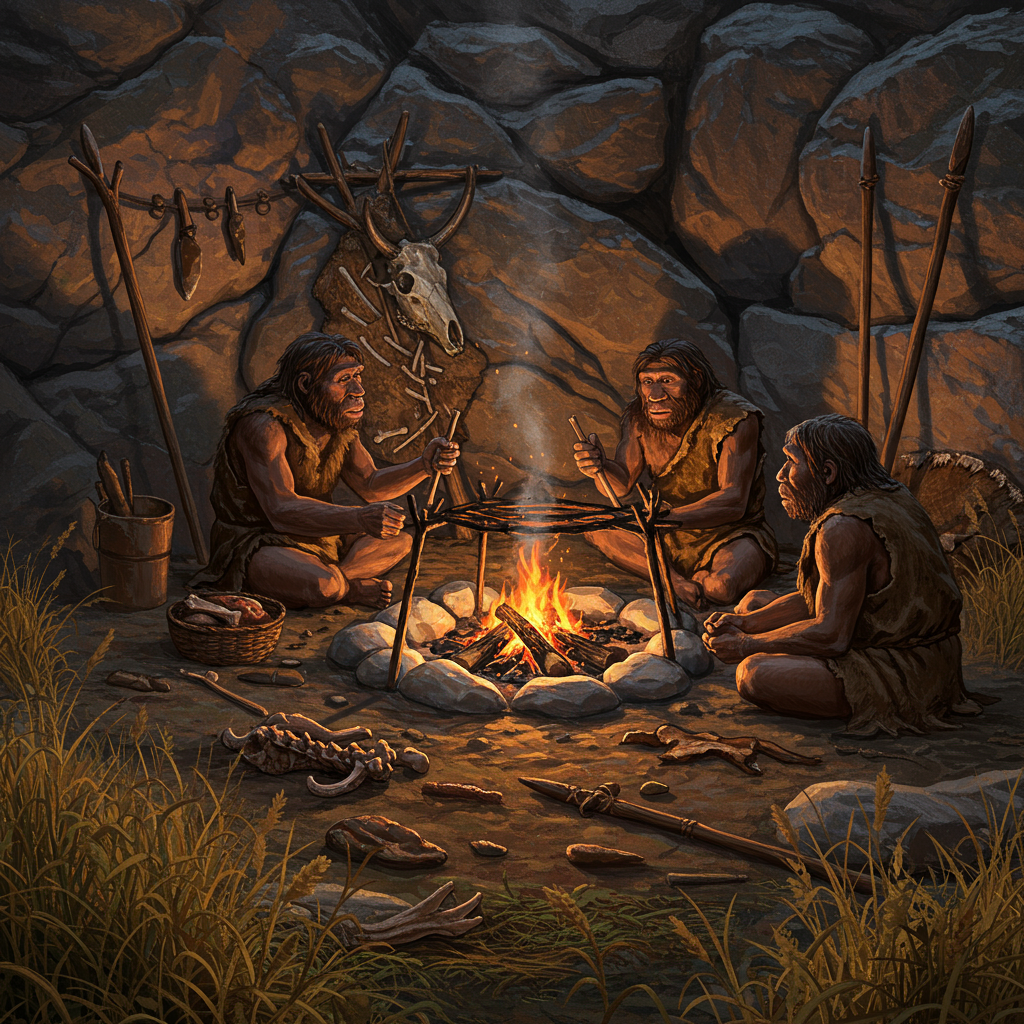Breakthrough archaeological evidence reveals that neanderthals were far more sophisticated than previously believed, engaging in complex food processing techniques like rendering fat from animal bones a staggering 125,000 years ago. This discovery pushes back the timeline for such advanced survival strategies by thousands of years, challenging outdated stereotypes and highlighting the remarkable intelligence and adaptability of our ancient relatives. It suggests Neanderthals possessed a deep understanding of nutrition and resource management long before similar practices were widely attributed to modern humans.
The “Fat Factory” Unearthed: Evidence from neumark-nord
A groundbreaking study, recently published in Science Advances, details compelling findings from central Germany. Researchers working at the Neumark-Nord 2/2B site have uncovered what appears to be a dedicated “fat factory.” This wasn’t just a random hunting spot; it was a specialized location where Neanderthals systematically processed large quantities of animal bones.
A Look at the Archaeological Site
The Neumark-Nord site is part of a remarkably well-preserved interglacial ecosystem. Discovered originally in the 1980s, it has yielded insights into various Neanderthal activities across different zones. The Neumark-Nord 2 site, specifically, was situated near the margin of an ancient lake or shallow pool, a key feature likely facilitating their processing methods.
Excavations conducted between 2004-2009 and more recently from 2020-2023 unearthed a dense concentration of bone fragments. The remains of over 170 large mammals were identified, including horses, bison, deer, and aurochs. This sheer volume indicates extensive processing, far beyond simple butchery or marrow extraction. The bones were found mixed with flint artifacts and hammerstones, providing direct evidence of human activity at the site.
Unpacking the Fat Rendering Process
The evidence strongly suggests a deliberate, multi-step process for extracting fat. Neanderthals first likely smashed large bones, such as femurs, using tools like hammerstones found at the site. This initial step allowed access to the calorie-rich bone marrow.
However, the processing went much further. The bones were then crushed and chopped into much smaller fragments. Researchers found extensive evidence of this fragmentation, particularly in spongy bone areas known to contain significant amounts of fat. These smaller pieces were then subjected to heat and water. The proximity to a water source would have been essential for boiling. Microscopic analysis of bone fragments revealed coloration and texture consistent with accidental exposure to fire after boiling, supporting the use of heating techniques.
The process involved boiling these bone fragments to render out the grease. The fat would then rise to the surface of the liquid, where it could be skimmed off. This complex technique demonstrates a sophisticated understanding of food chemistry and thermal processing. Lead author Dr. Lutz Kindler characterized this activity as “intensive, organized, and strategic.”
Why Fat Was a Survival Essential
For hunter-gatherers like Neanderthals, accessing sufficient calories and essential nutrients was paramount for survival. Their lifestyle demanded high energy expenditure. While their diet was predominantly meat-based, relying solely on lean protein could be dangerous.
The Role of Fat in Neanderthal Diet
Fat is a vital macronutrient, providing more than twice the calories per gram compared to protein or carbohydrates. This high energy density made it incredibly valuable, especially during periods when other food sources were scarce. Consuming large amounts of lean protein without sufficient fat or carbohydrates can lead to protein toxicity, sometimes called “rabbit starvation,” which can be fatal.
Extracting fat from bones allowed Neanderthals to balance their diet and avoid this dangerous condition. It provided a crucial source of energy and essential fatty acids. This was particularly important during harsh winter months when plant-based foods, a source of carbohydrates, were unavailable.
Adaptive Strategies for Survival
Developing fat rendering techniques was a powerful adaptation to environmental challenges. By processing fat-rich bones, Neanderthals could create a concentrated food source. Unlike fresh meat, bone grease could potentially be stored for later use, providing a caloric buffer during lean times.
This ability to plan for future food needs suggests a level of foresight and resource management previously underestimated in Neanderthals. It implies strategic thinking about hunting, transporting carcasses, and utilizing resources effectively. Some experts draw comparisons to the survival strategies of modern Arctic communities, who also rely heavily on fat.
Reshaping Our View of Neanderthal Capabilities
The discovery at Neumark-Nord fundamentally challenges the long-held stereotype of Neanderthals as simple or brutish. This “fat factory” reveals a species capable of complex thought, organization, and technological skill.
Beyond the Stereotype: Intelligence and Planning
The sophistication of the fat rendering process points to advanced cognitive abilities. It required understanding the nutritional value of different parts of an animal, the necessary steps to extract those nutrients, and the tools and conditions required (like proximity to water and controlled use of fire). The dedicated nature of the site further suggests intentional planning – bringing large quantities of bones to a specific location for processing.
Researchers note that this level of organization and strategic resource management indicates foresight. Neanderthals weren’t just opportunistically scavenging; they were actively working to maximize their caloric intake and ensure future food security. This counters the image of a species solely focused on immediate needs.
Resourcefulness and Collective Effort
Neanderthals demonstrated remarkable resourcefulness by extracting every possible nutrient from their prey. Beyond marrow, they utilized the fat embedded in the bones. The sheer scale of the operation at Neumark-Nord, involving over 170 animals, suggests it may have been a collective effort. Group coordination would have been beneficial for hunting, transporting large carcasses, and the labor-intensive processing.
The site also provides evidence of sophisticated tool use, with specific anvils and hammerstones tailored for bone processing. The controlled use of fire for boiling further highlights their technological skills. The discovery aligns with other findings that show Neanderthals were capable fire-users, toolmakers, and organized hunters.
Broader Implications and Future Research
The Neumark-Nord findings significantly alter the timeline of sophisticated food processing in human history. It indicates that Neanderthals were innovating and adapting in ways that parallel, and in this specific case potentially predate, behaviors previously thought unique to or first developed by early modern humans. This challenges the strict divide often drawn between Neanderthals and Homo sapiens.
The potential mass hunting evident at Neumark-Nord and nearby sites, involving species like rhinos and elephants, also raises questions about the environmental impact of Neanderthal activities on local fauna during the Last Interglacial period.
While Neumark-Nord offers unprecedented detail, similar bone processing patterns at other European and Middle Eastern sites suggest this practice might have been more widespread than currently documented. Future research could focus on residue analysis of bone fragments to find direct chemical evidence of fat. Experimental archaeology, replicating the process, can provide further insights into the techniques used. Comparative studies with modern foraging societies and genetic research into fat metabolism adaptations could also enhance our understanding.
Ultimately, the “fat factory” discovery paints a picture of Neanderthals not as brutish cave dwellers, but as intelligent, adaptable, and socially organized hominins capable of complex planning and technological innovation crucial for survival in challenging environments.
Frequently Asked Questions
How did Neanderthals extract fat from bones 125,000 years ago?
Evidence from the Neumark-Nord site suggests Neanderthals used a sophisticated, multi-step process. They first broke open large animal bones to access marrow. Then, they crushed and chopped the bones into smaller pieces. These fragments were likely boiled in water, possibly using fire, to render out the fat. The fat would rise to the surface and could then be skimmed off, creating a calorie-rich bone grease.
Why was extracting fat from animal bones so crucial for Neanderthal survival?
Fat was a vital nutrient for Neanderthals, providing high energy crucial for their demanding hunter-gatherer lifestyle. It helped them avoid “rabbit starvation,” a dangerous condition from excessive lean protein consumption without enough fat or carbs. Fat was particularly important during cold periods or seasonal scarcity when other food sources like plants were limited. Rendering fat also created a potentially storable food source.
Where was the “fat factory” site discovered, and what is its significance?
The site was discovered at Neumark-Nord 2/2B in central Germany, near an ancient lakeshore. Its significance is immense: it provides the earliest strong evidence of systematic fat rendering by Neanderthals, pushing back the timeline for this advanced technique by thousands of years. It challenges traditional views, showing Neanderthals were intelligent, organized, resourceful, and capable of complex planning and resource management, much like early modern humans.
—
The Neumark-Nord “fat factory” discovery is a powerful reminder that our understanding of ancient human behavior is constantly evolving. It highlights the intelligence, adaptability, and complex strategies employed by Neanderthals to thrive in their world. Far from being simple counterparts to modern humans, they were innovators in their own right, capable of sophisticated techniques that ensured their survival through difficult times. This finding encourages a deeper appreciation for the capabilities of all hominin species that shaped our shared evolutionary history.




